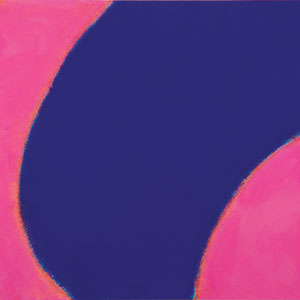

If the painter Mark Rothko reincarnated as an Indian woman in Silicon Valley, his name would be Chandrika Marla.
In a style reminiscent of Rothko, Marla explores the beauty of the female form through vibrant colors. Her new exhibit, “Women in High Chroma” opens on September 17th at Menlo Park’s Art Ventures Gallery and runs through October 23rd.
On the afternoon that I hit Santa Cruz Avenue in Menlo Park, much of the road remains blocked off and set aside for outdoor dining. Eateries for the affluent and the comfortable dominate the scene.
Inside Art Ventures Gallery, Marla shows me one of her paintings, titled, “Take Me Away.” In describing the work, she mentions a woman’s breasts and shoulders, before turning the canvas upside-down to reveal a different perspective. Like an optical illusion, positive and negative spaces tend to blur.
“The purple is the positive part,” Marla says. “But for you the pink might be the positive part.” If I zoom in real close on the fuzzy border zone area where the larger shapes of color fade into each other, I see a tiny, complex, multicolored mesh. Marla says the border area indicates all the colors she’s leaving behind in the process of creating the larger painting.
“I feel this is like an aura, all the colors that are buzzing all around us,” she says. Marla lost her dad when she was nine years old, back in India and themes of displacement, grief, distance, isolation and abandonment lay buried within the colors, it seems. The colors along the border represent the vibrant range of hues Marla grew up with, the vibrancy she’s long-since left behind. All of which is inseparable from losing her dad at a young age, leaving her wondering where he might possibly be.
“It’s a very complex answer to a very simple question,” she says, casually. “Where did my father go?”
Born in New Delhi in 1968, Marla came to the U.S. in 1998 and for years worked in Chicago as a fashion designer, a career that left her with a visual vocabulary of the female body. Then she got laid off and started taking art classes, immediately relishing in the excitement of not having to create work for somebody else.
Marla’s teacher encouraged her to do what she wanted, seeing that she had a knack for color and working with very simple shapes. Marla was mesmerized by Rothko, through whom she found her own voice.
“I learned that I could use very few lines to show a lot of emotion,” Marla says. “Maybe not feel a lot of things, but for myself, it was a lot of color layered that you couldn’t see. So it was kind of secretive. It was mysterious.”
And when certain border-zone areas emerge, one can see emotions that still linger, but also somehow remain hidden. Like auras. Such are the in-between spaces where colors meet in Marla’s paintings.
As she continues with “Take Me Away,” flipping it around and leaning it up against the gallery wall, Marla says the painting started in a different orientation.
The purple part began as the shape of a female breast, but as an abstract entity that flowed off the canvas. After three weeks of adding layers, she flipped the painting 90 degrees, revealing a whole new perspective. To Marla, the pink forms then looked like two people communicating. And the purple part, which was originally a different color, looked like a tornado coming towards the viewer.
“The feeling of that female shape changed into a feeling of just ‘take me away,’ which is what it’s called,” Marla explains. “Just to be in that escape of ‘getting away,’ because I think that we’re all just trapped at home right now. There were all these, just, feelings of wanting to be with somebody somewhere else, just out of your own house.”
We can all relate. As Marla describes her other paintings, including one inspired by a visit to the Frida Kahlo Museum in Mexico City, aka The Blue House, I am glad to be taken away.



